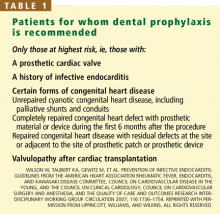Infective endocarditis prophylaxis before dental procedures: New guidelines spark controversy
THOUGHTS AND CHALLENGES
Although prophylaxis has been a standard practice for years, its efficacy and cost-effectiveness have never been proven, owing to a lack of prospective randomized controlled trials. A sequential relationship between dental procedures and infective endocarditis can be demonstrated in only 4% to 7.5% of cases.5 Most cases of infective endocarditis are not preceded by dental procedures.
Furthermore, the data are limited and insufficient to substantiate the efficacy of antibiotics in preventing endocarditis in patients with high-risk cardiac conditions who undergo dental procedures.6 Failures have occurred even when the infecting microorganism was susceptible to the antibiotic given for prophylaxis. Since bacteremia occurs also during brushing and flossing of teeth, why give prophylaxis just for dental procedures? Moreover, the risks of causing adverse or anaphylactic reactions from antibiotics, as well as contributing to the nationwide antibiotic resistance problem, are issues not to be taken lightly.
Poor compliance with prophylaxis has been documented. Studies by Duval et al7 and others have shown that practitioners adhere to recommended dental prophylaxis programs only about 40% of the time, while only 22% of patients with predisposing cardiac conditions could recall taking their prescribed prophylactic antibiotics before an indicated procedure, as recommended.8
NEW GUIDELINES—2007
To address many of these concerns, the American Heart Association1 released extensively revised guidelines in 2007. They are more pragmatic, narrowly focused for a selected group of patients who have a greater lifetime risk of illness and death from infective endocarditis.
The experts who wrote the guidelines agreed that evidence remains poor about which dental procedures increase the risk of infective endocarditis and the efficacy of antibiotic prophylaxis to prevent its development. They stress the importance of good oral hygiene and prevention of dental disease and argue persuasively that this will have a greater impact on decreasing the lifetime risk of infective endocarditis than will antibiotic prophylaxis.
Prophylaxis is now recommended only for patients with a prosthetic heart valve, a history of infective endocarditis, certain forms of congenital heart disease, and valvulopathy after cardiac transplantation (Table 1), and only before procedures that involve manipulation of gingival tissue or the periapical region of teeth, or perforation of the oral mucosa. Excluded are routine dental cleaning and anesthetic injections through noninfected tissue, dental radiography, placement and adjustment of appliances, shedding of deciduous teeth, and bleeding from trauma to the lips.
CONTROVERSY WILL CONTINUE
The new guidelines for dental prophylaxis have been extensively revised and simplified. They are now focused only on patients who have a greater lifetime risk of illness and death from infective endocarditis. But what about patients who had previously been advised to take prophylaxis, such as those with mitral valve prolapse with regurgitation, who will not receive prophylaxis any more?
These guidelines will likely stir emotions, not only for practitioners who have strong desires to practice preventive medicine, but also for patients who have been taking prophylaxis in good faith per previous guidelines. They may feel abandoned. Unfortunately, funding for a prospective randomized clinical trial large enough to prove that antibiotic prophylaxis for dental procedures benefits patients is unlikely. That leaves us with the current recommendations, which are based on scientific evidence that currently exists and on expert opinion.
The intention of the guidelines is laudable. Of course, there will continue to be controversies with the new rules. Nevertheless, we believe they should be followed until there is more persuasive evidence to the contrary.








